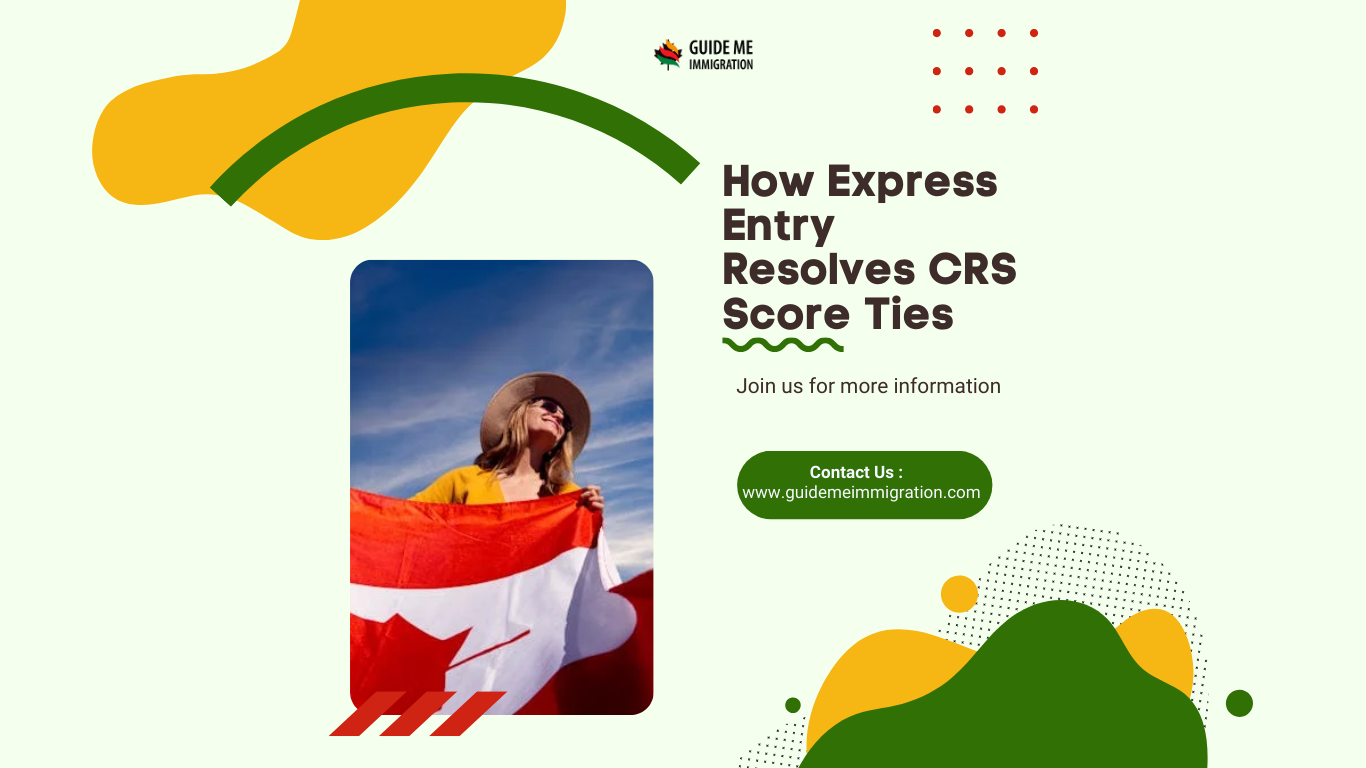Understanding Express Entry’s Tie-Breaking Rule: A Detailed Guide
Canada has long been a popular destination for individuals seeking to immigrate for better opportunities, and the Express Entry system is one of the most common pathways for skilled workers, trade professionals, and those with Canadian work experience to obtain permanent residency. However, the process can be complicated, particularly during draws where many candidates share the same Comprehensive Ranking System (CRS) score. This is where the tie-breaking rule becomes crucial.
In this guide, we will explore the tie-breaking rule in Express Entry in detail, providing an in-depth understanding of how it works, why it is necessary, and how it impacts candidates in the system. By the end of this article, you’ll have a clear grasp of this rule, along with tips on how to improve your chances in the pool.
What Is Express Entry?
Before diving into the tie-breaking rule itself, it’s important to first understand how the Express Entry system works. The Express Entry program is the Canadian federal immigration system used to manage applications for permanent residency under three primary programs:
- Federal Skilled Worker Program (FSW): For skilled workers with foreign work experience.
- Federal Skilled Trades Program (FSTP): For skilled tradespeople who meet the specific trade qualifications.
- Canadian Experience Class (CEC): For candidates with Canadian work experience.
Candidates who meet the criteria for these programs are invited to apply for permanent residence through a point-based system that ranks candidates based on their CRS score. This score is influenced by factors such as age, education, language proficiency, work experience, and other aspects like provincial nominations or job offers.
Each year, draws are held in which candidates with the highest CRS scores are invited to apply for permanent residency. However, not all draws are straightforward; sometimes, candidates with identical CRS scores may find themselves vying for an invitation. This is where the tie-breaking rule comes into play.
What is the Tie-Breaking Rule in Express Entry?
The tie-breaking rule is a system that helps Canadian immigration officials prioritize candidates when two or more have the same CRS score in a draw. It determines which applicants are invited to apply for permanent residency based on when they submitted their Express Entry profile.
How Does the Tie-Breaking Rule Work?
If you’re in the Express Entry pool and have the same CRS score as another candidate, the tie-breaking rule ensures fairness in the selection process. Here’s a breakdown of how it works:
- CRS Score Matching: Candidates are ranked based on their CRS scores, which assess various factors like age, education, work experience, language proficiency, and more.
- Tie Scenario: If multiple candidates have the same CRS score, the tie-breaking rule is used to determine the order in which candidates are invited.
- Date and Time Stamp: The rule uses the submission date and time of the candidate’s profile. The system will give preference to candidates who submitted their profiles earlier. For example, if there is a tie in the CRS score and the tie-breaking rule sets a specific date and time (e.g., 12:00 PM on January 1st), candidates who submitted their profile before this timestamp will be invited to apply first.
- Tie-Breaking Announcement: Each time a draw occurs, Immigration, Refugees and Citizenship Canada (IRCC) announces the tie-break date and time along with the CRS score cutoff. The announcement helps applicants understand whether they were selected in that draw and whether they need to submit a new profile to improve their chances.
Let’s go through an example to understand this rule further.
Example:
- Suppose in a particular Express Entry draw, the CRS cutoff score is set to 470 points.
- 50 candidates have a CRS score of 470.
- The tie-breaking rule for this draw is set to January 1st, 12:00 PM.
Now, even though all these candidates have the same CRS score, those who submitted their profiles before 12:00 PM on January 1st will be invited to apply for permanent residency first. If you submitted your profile after this time, despite having the same CRS score, you won’t be invited in this round, although your profile is still active in the pool for future draws.
Why Is the Tie-Breaking Rule Necessary?
The tie-breaking rule is designed to bring clarity and fairness to the process. Without it, Canada’s immigration system could become bogged down by uncertainty over how to prioritize candidates with identical scores. This rule ensures that:
- Fairness: Candidates who have been waiting in the pool longer are given priority, and no candidate is left in limbo.
- Transparency: Candidates can clearly see how the draw process works and how the tie-breaking rule is applied. It removes the ambiguity from the process and helps candidates plan accordingly.
- Predictability: Knowing that the system is based on an objective, timestamp-based rule gives applicants more confidence in the draw process.
- Efficiency: By using a systematic method to break ties, the process runs more smoothly, without any confusion or unnecessary delays in processing invitations.
Factors Affecting the Tie-Breaking Rule
While the tie-breaking rule primarily relies on the submission date and time, other factors could influence your chances of receiving an Invitation to Apply (ITA):
- Provincial Nominee Program (PNP): If you have a provincial nomination, you are awarded additional points to your CRS score, significantly improving your chances of being invited, especially during competitive draws. This means that in case of a tie, candidates with a provincial nomination will typically be prioritized.
- Job Offer: A valid job offer from a Canadian employer can also enhance your CRS score. Candidates with job offers are more likely to be invited to apply in case of a tie, as job offers typically increase your CRS score.
- Language Proficiency: If you improve your language proficiency in English or French, it can significantly increase your CRS score, making you more competitive in the pool. This factor can help candidates break ties with others who may have the same CRS score but lower language proficiency.
- Canadian Work Experience: Having Canadian work experience is another key factor that can push you higher up in the CRS rankings, making your profile more likely to be selected in a draw, especially if you’re competing against other candidates with the same CRS score.
- Other Factors: Candidates with French language skills, a sibling in Canada, or who meet other criteria may also receive extra points, which could affect their ranking during the tie-breaking process.
Improving Your CRS Score to Avoid Ties
While the tie-breaking rule gives priority to candidates based on the submission time, the best way to maximize your chances of receiving an ITA is to improve your CRS score. Here are a few strategies:
- Improve Your Language Score: Achieving higher results in the IELTS or TEF exams can substantially increase your score.
- Gain More Work Experience: Acquiring additional work experience, especially in skilled occupations, can increase your points.
- Pursue Further Education: Completing a higher level of education or getting an additional credential can add valuable points.
- Obtain a Provincial Nomination: Applying for a provincial nomination through one of the PNP programs can boost your CRS score by 600 points, virtually guaranteeing you an ITA.
- Secure a Job Offer: If you’re able to get a job offer from a Canadian employer, it will provide an additional boost to your CRS score.
Managing Expectations: When to Expect an ITA
It’s crucial to set realistic expectations when waiting for an ITA. While the tie-breaking rule may feel like a gamble, knowing when and why you are being prioritized can help you stay informed. Always track the tie-break dates from previous draws to estimate your chances of being selected in upcoming draws.
Even if you don’t receive an ITA immediately, your profile will remain in the pool, and you can continue working on improving your CRS score for future draws.
Conclusion
The tie-breaking rule in Express Entry is a key element of Canada’s immigration system. It ensures that candidates with the same CRS score are selected based on the date and time of their profile submission. This rule provides fairness, transparency, and efficiency to the immigration process, ensuring that applicants who have waited longer in the pool are prioritized.
By understanding how this rule works and how it impacts your chances, you can better prepare your application, manage your expectations, and increase your odds of receiving an ITA.
If you need assistance navigating the Express Entry system or improving your CRS score, Guide Me Immigration is here to help. We offer expert advice and personalized support to help you achieve your immigration goals.
📍 Saskatoon: 535 20th St West, Unit-C, Saskatoon, SK S7M 0X6
📍 Regina: Unit 170 – 2410 Dewdney Ave, Regina, SK S4R 1H6
📍 Dhaka: Apt-2D, H-396, R-6 Avenue 3, Dhaka 1216, Bangladesh
✉ Email: info@guidemeimmigration.com
📞 Call: +1 (306) 700 7440
🌐 Website: www.guidemeimmigration.com
Alternative Website:http://go-get.ca







